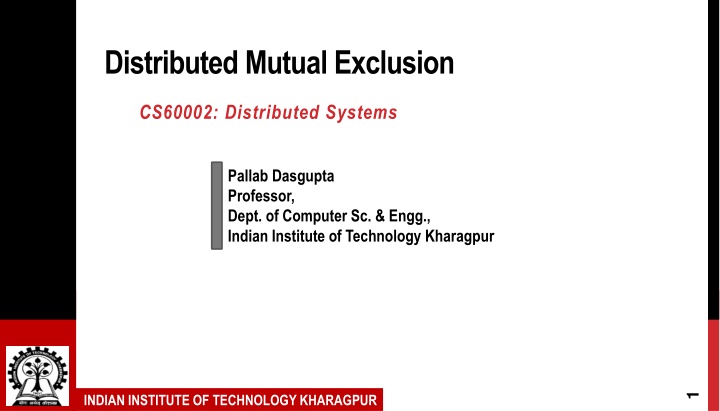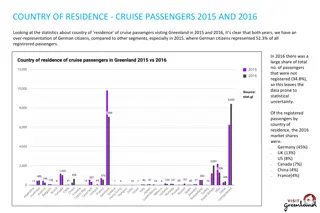
Distributed Mutual Exclusion Algorithms
Dive into the world of distributed mutual exclusion algorithms, exploring concepts like safety, liveness, no starvation, and fairness. Discover various types of algorithms such as non-token based and token-based approaches and delve into the complexity measures involved. Learn about Lamport's Algorithm and how it enforces total ordering for critical section requests.
Download Presentation

Please find below an Image/Link to download the presentation.
The content on the website is provided AS IS for your information and personal use only. It may not be sold, licensed, or shared on other websites without obtaining consent from the author. If you encounter any issues during the download, it is possible that the publisher has removed the file from their server.
You are allowed to download the files provided on this website for personal or commercial use, subject to the condition that they are used lawfully. All files are the property of their respective owners.
The content on the website is provided AS IS for your information and personal use only. It may not be sold, licensed, or shared on other websites without obtaining consent from the author.
E N D
Presentation Transcript
Distributed Mutual Exclusion CS60002: Distributed Systems Pallab Dasgupta Professor, Dept. of Computer Sc. & Engg., Indian Institute of Technology Kharagpur 1 INDIAN INSTITUTE OF TECHNOLOGY KHARAGPUR
Mutual Exclusion Very well-understood in shared memory systems Requirements: at most one process in critical section (safety) if more than one requesting process, someone enters (liveness) a requesting process enters within a finite time (no starvation) requests are granted in order (fairness) 2 INDIAN INSTITUTE OF TECHNOLOGY KHARAGPUR
Types of Dist. Mutual Exclusion Algorithms Non-token based / Permission based Permission from all processes: e.g. Lamport, Ricart-Agarwala, Raicourol-Carvalho etc. Permission from a subset: ex. Maekawa Token based ex. Suzuki-Kasami 3 INDIAN INSTITUTE OF TECHNOLOGY KHARAGPUR
Some Complexity Measures No. of messages/critical section entry Synchronization delay Response time Throughput 4 INDIAN INSTITUTE OF TECHNOLOGY KHARAGPUR
Lamports Algorithm Every node i has a request queue qi keeps requests sorted by logical timestamps (total ordering enforced by including process id in the timestamps) To request critical section: send timestamped REQUEST(tsi, i) to all other nodes put (tsi, i) in its own queue On receiving a request (tsi, i): send timestamped REPLY to the requesting node i put request (tsi, i) in the queue 5 INDIAN INSTITUTE OF TECHNOLOGY KHARAGPUR
Lamports Algorithm contd.. To enter critical section: Process i enters critical section if: (tsi, i) is at the top if its own queue, and Process i has received a message (any message) with timestamp larger than (tsi, i) from ALL other nodes. To release critical section: Process i removes its request from its own queue and sends a timestamped RELEASE message to all other nodes On receiving a RELEASE message from i, i s request is removed from the local request queue 6 INDIAN INSTITUTE OF TECHNOLOGY KHARAGPUR
Some notable points Purpose of REPLY messages from node i to j is to ensure that j knows of all requests of i prior to sending the REPLY (and therefore, possibly any request of i with timestamp lower than j s request) Requires FIFO channels. 3(n 1 ) messages per critical section invocation Synchronization delay = max mesg transmission time Requests are granted in order of increasing timestamps 7 INDIAN INSTITUTE OF TECHNOLOGY KHARAGPUR
The Ricart-Agrawala Algorithm Improvement over Lamport s Main Idea: node j need not send a REPLY to node i if j has a request with timestamp lower than the request of i (since i cannot enter before j anyway in this case) Does not require FIFO 2(n 1) messages per critical section invocation Synchronization delay = max. message transmission time Requests granted in order of increasing timestamps 8 INDIAN INSTITUTE OF TECHNOLOGY KHARAGPUR
The Ricart-Agrawala Algorithm To request critical section: send timestamped REQUEST message (tsi, i) On receiving request (tsi, i) at j: send REPLY to i if j is neither requesting nor executing critical section or if j is requesting and i s request timestamp is smaller than j s request timestamp. Otherwise, defer the request. To enter critical section: i enters critical section on receiving REPLY from all nodes To release critical section: send REPLY to all deferred requests 9 INDIAN INSTITUTE OF TECHNOLOGY KHARAGPUR
Roucairol-Carvalho Algorithm Improvement over Ricart-Agarwala Main idea Once i has received a REPLY from j, it does not need to send a REQUEST to j again unless it sends a REPLY to j (in response to a REQUEST from j) Message complexity varies between 0 and 2(n 1) depending on the request pattern worst case message complexity still the same 10 INDIAN INSTITUTE OF TECHNOLOGY KHARAGPUR
Maekawas Algorithm Permission obtained from only a subset of other processes, called the Request Set (or Quorum) Separate Request Set, Ri, for each process i Requirements: for all i, j: Ri Rj for all i: i Ri for all i: |Ri| = K, for some K any node i is contained in exactly D Request Sets, for some D = = K for Maekawa s D N 11 INDIAN INSTITUTE OF TECHNOLOGY KHARAGPUR
A Simple Version To request critical section: i sends REQUEST message to all process in Ri On receiving a REQUEST message: Send a REPLY message if no REPLY message has been sent since the last RELEASE message is received. Update status to indicate that a REPLY has been sent. Otherwise, queue up the REQUEST To enter critical section: i enters critical section after receiving REPLY from all nodes in Ri 12 INDIAN INSTITUTE OF TECHNOLOGY KHARAGPUR
A Simple Version contd.. To release critical section: Send RELEASE message to all nodes in Ri On receiving a RELEASE message, send REPLY to next node in queue and delete the node from the queue. If queue is empty, update status to indicate no REPLY message has been sent. 13 INDIAN INSTITUTE OF TECHNOLOGY KHARAGPUR
Features Message Complexity: N 3 * Synchronization delay = 2*(max message transmission time) Major problem: DEADLOCK possible Need three more types of messages (FAILED, INQUIRE, YIELD) to handle deadlock. Message complexity can be 5*sqrt(N) Building the request sets? 14 INDIAN INSTITUTE OF TECHNOLOGY KHARAGPUR
Token based Algorithms Single token circulates, enter CS when token is present Mutual exclusion obvious Algorithms differ in how to find and get the token Uses sequence numbers rather than timestamps to differentiate between old and current requests 15 INDIAN INSTITUTE OF TECHNOLOGY KHARAGPUR
Suzuki Kasami Algorithm Broadcast a request for the token Process with the token sends it to the requestor if it does not need it Issues: Current versus outdated requests Determining sites with pending requests Deciding which site to give the token to 16 INDIAN INSTITUTE OF TECHNOLOGY KHARAGPUR
Suzuki Kasami Algorithm The token: Queue (FIFO) Q of requesting processes LN[1..n] : sequence number of request that j executed most recently The request message: REQUEST(i, k): request message from node i for its kth critical section execution Other data structures RNi[1..n] for each node i, where RNi[ j ] is the largest sequence number received so far by i in a REQUEST message from j. 17 INDIAN INSTITUTE OF TECHNOLOGY KHARAGPUR
Suzuki Kasami Algorithm To request critical section: If i does not have token, increment RNi[ i ] and send REQUEST(i, RNi[ i ]) to all nodes If i has token already, enter critical section if the token is idle (no pending requests), else follow rule to release critical section On receiving REQUEST(i, sn) at j: Set RNj[ i ] = max(RNj[ i ], sn) If j has the token and the token is idle, then send it to i if RNj[ i ] = LN[ i ] + 1. If token is not idle, follow rule to release critical section 18 INDIAN INSTITUTE OF TECHNOLOGY KHARAGPUR
Suzuki Kasami Algorithm To enter critical section: Enter CS if token is present To release critical section: Set LN[ i ] = RNi[ i ] For every node j which is not in Q (in token), add node j to Q if RNi[ j ] = LN[ j ] + 1 If Q is non empty after the above, delete first node from Q and send the token to that node 19 INDIAN INSTITUTE OF TECHNOLOGY KHARAGPUR
Notable features No. of messages: 0 if node holds the token already, n otherwise Synchronization delay: 0 (node has the token) or max. message delay (token is elsewhere) No starvation 20 INDIAN INSTITUTE OF TECHNOLOGY KHARAGPUR
Raymonds Algorithm Forms a directed tree (logical) with the token-holder as root Each node has variable Holder that points to its parent on the path to the root. Root s Holder variable points to itself Each node i has a FIFO request queue Qi 21 INDIAN INSTITUTE OF TECHNOLOGY KHARAGPUR
Raymonds Algorithm To request critical section: Send REQUEST to parent on the tree, provided i does not hold the token currently and Qi is empty. Then place request in Qi When a non-root node j receives a request from i place request in Qj send REQUEST to parent if no previous REQUEST sent 22 INDIAN INSTITUTE OF TECHNOLOGY KHARAGPUR
Raymonds Algorithm When the root receives a REQUEST: send the token to the requesting node set Holder variable to point to that node When a node receives the token: delete first entry from the queue send token to that node set Holder variable to point to that node if queue is non-empty, send a REQUEST message to the parent (node pointed at by Holder variable) 23 INDIAN INSTITUTE OF TECHNOLOGY KHARAGPUR
Raymonds Algorithm To execute critical section: enter if token is received and own entry is at the top of the queue; delete the entry from the queue To release critical section if queue is non-empty, delete first entry from the queue, send token to that node and make Holder variable point to that node If queue is still non-empty, send a REQUEST message to the parent (node pointed at by Holder variable) 24 INDIAN INSTITUTE OF TECHNOLOGY KHARAGPUR
Notable features Average message complexity: O(log n) Sync. delay = (T log n)/2, where T = max. message delay 25 INDIAN INSTITUTE OF TECHNOLOGY KHARAGPUR
















